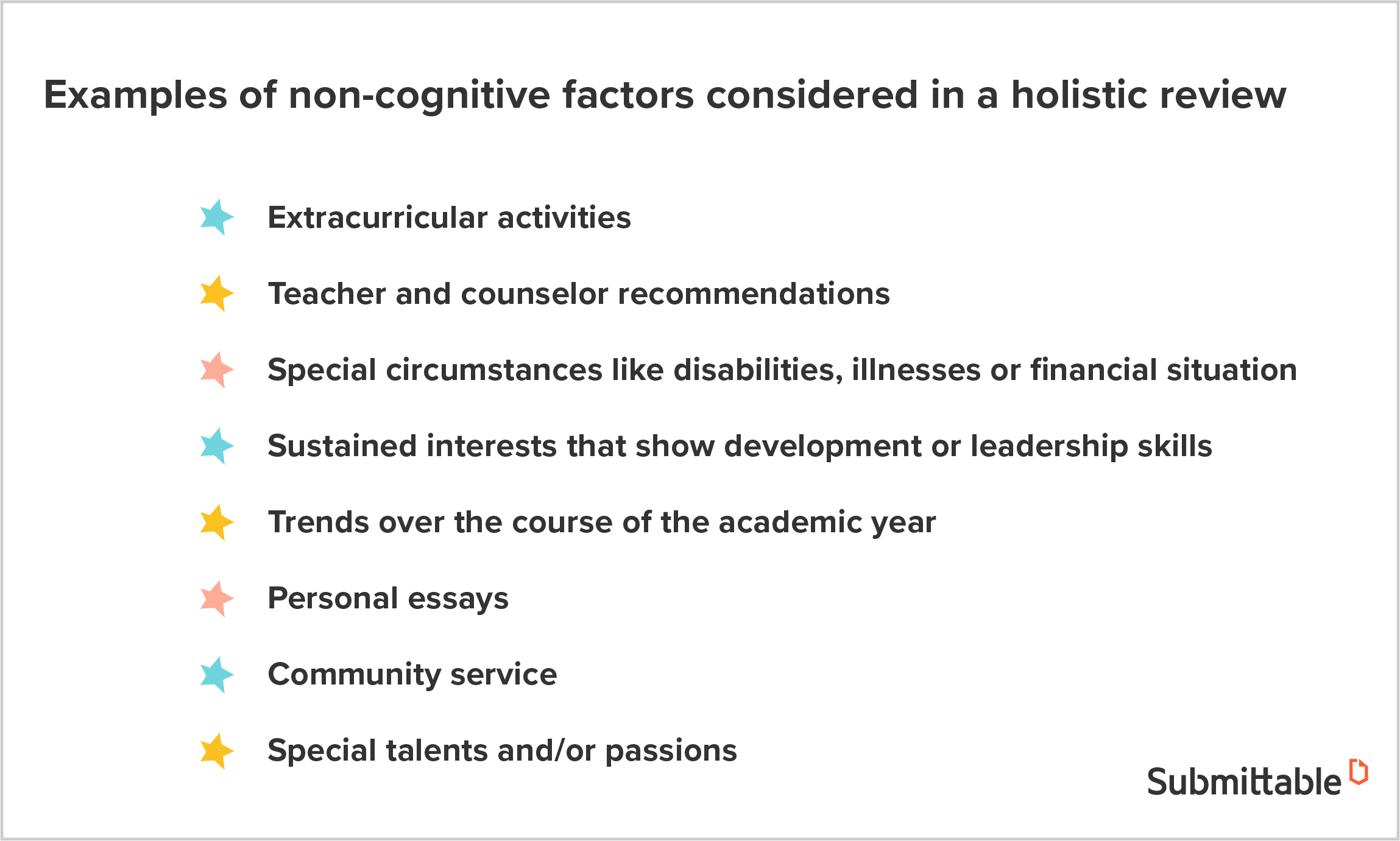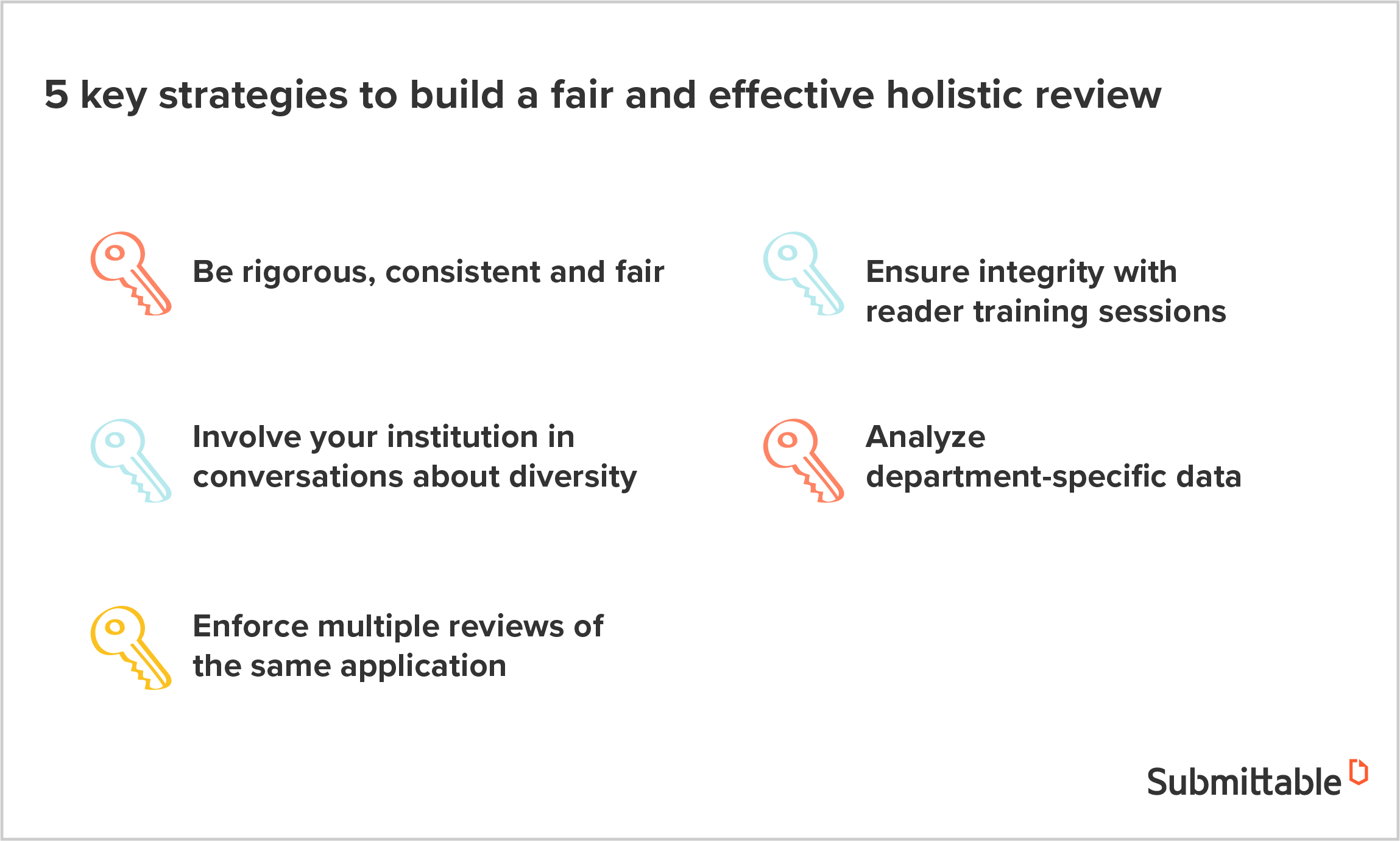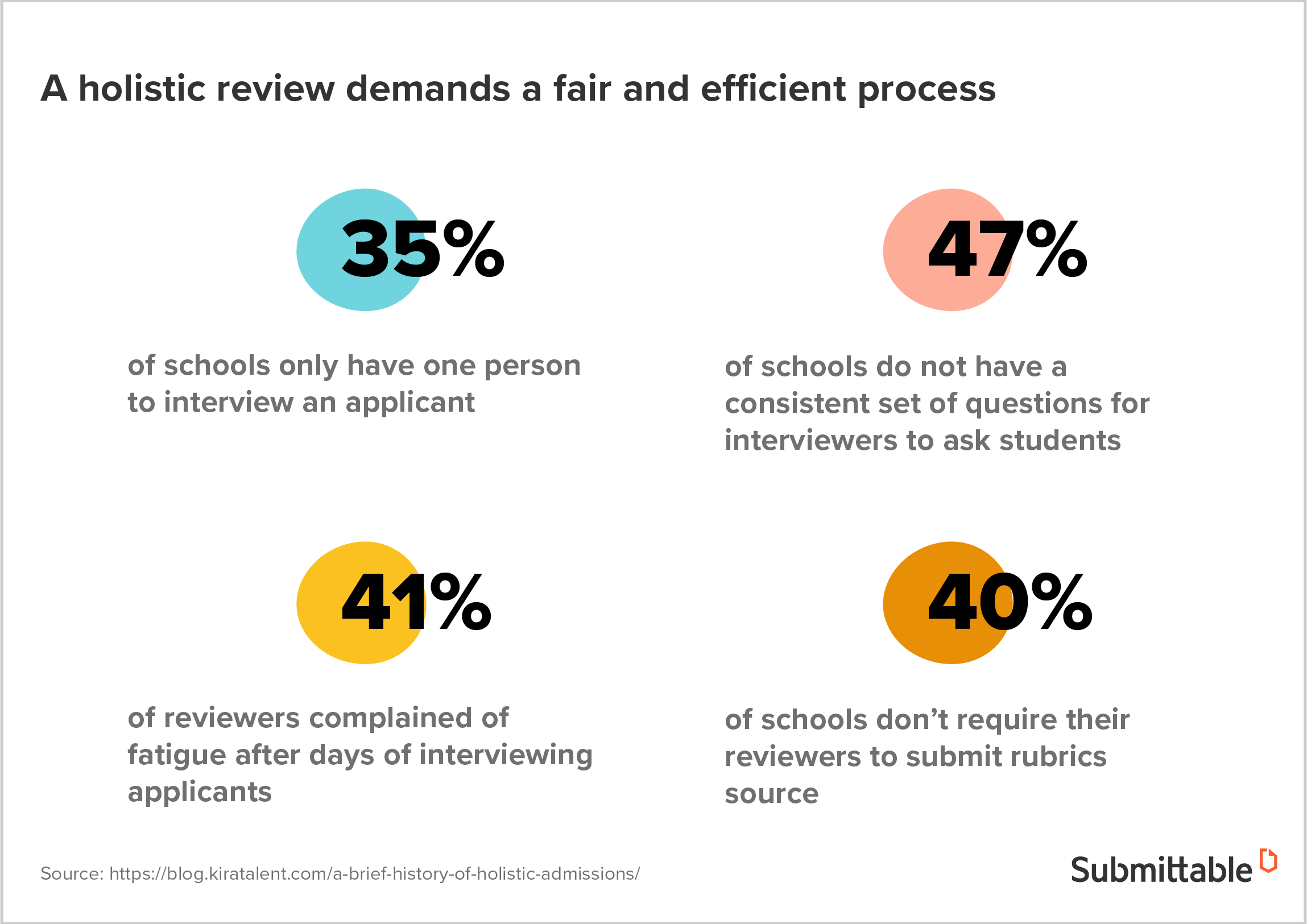What makes the best kind of student? Over the years, higher ed professionals have found that while test scores and grades are important, they don’t nearly paint a complete picture of how a student will thrive, add to the community, or contribute down the road as an alum.
Holistic review is a strategy used by universities and colleges to assess whether a candidate is a right fit—based on non-cognitive factors.
Most students and their families are familiar with the hard factors colleges have always taken into consideration. GPA results, test scores, references, and further academic achievements have until recently been king in the college review process.
But not many are aware of the “soft factors” top colleges are starting to place importance on, and that’s where the holistic review comes in.

Holistic college admissions explained
In its most basic form, holistic admissions is a strategy designed to help institutions assess the preparedness and fit of an applicant based on a broad range of factors.
Holistic college admissions creates a more equitable system for evaluating potential students. Rather than placing the bulk of the consideration on traditional academic factors (namely, GPA and test scores), a holistic approach includes a number of factors that may not be captured in a traditional admissions process.
Factors often considered include:
- Extracurricular activities
- Recommendations from teachers or counselors
- Special or mitigating circumstances
- Unique experiences
- Civic engagement
Why some colleges use a holistic admissions review
Colleges are using this process for many reasons, although one core goal of using a holistic review is to assemble a diverse student body. In this case, diversity isn’t confined to racial backgrounds, but also socioeconomic status, life experience, and general background.
A common misconception is that colleges use the soft factors in the holistic review as deciding factors for an applicant. Soft factors are not considered independently and they’re not used for numerical points.
Benefits of a holistic review in college admissions
A recent report described the holistic process as a “means to look beyond just the objectives like test scores and GPA to really try to get to know the applicant as a student and as a person.”
The US Supreme Court officially described the review process as “a highly individualized review of each applicant’s file, giving serious consideration to all the ways an applicant might contribute to a diverse educational environment”.
It’s a way for colleges to assess a student in their entirety rather than numerical test score results alone, with all the provided information used as context to evaluate a candidate’s uniqueness.
Balancing the scales for students with fewer educational privileges
Aside from spiraling costs and working through cultural differences with their middle or upper-class peers, low-income students have often had difficulties fitting into the college equation. But before going to college even becomes a concern, many low-income students don’t have the privilege of even considering further education as a viable option.
Many urban public schools simply don’t have the substantial resources to deliver adequate academic preparation to students.
To get into advanced math class in middle school, a student would have to be prepped in elementary school. To get into the honors course in high school, students would have had to excel in middle school, and so on.
It means that many low-income families may believe college to be automatically out of reach, perhaps then not focusing on studying to prepare for that path.
So, for many students, a holistic review is the difference between attending college or not. It helps to bridge that gap, allowing candidates to stand out through other merits.
A holistic review:
- Allows colleges to consider each student as a unique, whole person rather than a numerical test score result
- Promotes a more diverse student body as applicants are judged on a broader scale of qualities
- Provides a more valuable evaluation of potential and soft skills
- Allows admissions officers to get an idea of an applicant’s work ethic
- Makes it easier to predict a student’s success both in class and life after college as alumni
Challenges with a holistic review
For colleges and universities that strive to diversify their student body, the holistic review works. But compared to standardized admissions, it comes with several challenges.
For one thing, this type of review requires increased amounts of effort and resources from the college, adding to an already thorough and lengthy process. Let’s look at a few challenges colleges may face while using the holistic review.
A holistic review might be:
- Time-consuming. Reviewing applications in a holistic manner takes a lot of work. Multiple readers are required to go over the same application in order to make a better-informed decision and to minimize bias.
- Difficult to explain. For some colleges, having a wider, better-qualified pool or students has meant rejecting students with perfect grades in favor of those selected using the holistic approach. This makes decisions more difficult to explain to a high academic achiever.
- Taken personally. A big challenge with a process that promises to judge a student as a whole person rather than a GPA score is the risk of rejected students taking the decision personally. Students that have excelled academically and ticked all the right boxes (yet are rejected) can be left feeling extremely disheartened and confused. Without thoughtful communication, colleges may give students the impression that their ‘personal’ qualities were not good enough.
Building a fair and effective holistic review process

At the core of any holistic program are fairness, integrity, and ongoing evaluation.
Although admissions criteria vary from school to school (as they are tied to an institution’s mission and goals), there are a few criteria they should all fill. Here are five actionable practices educational institutions can add to their existing process for an effective and equitable holistic review.
Use the same criteria across students
When judging an application holistically, it’s important to use the same baseline criteria and the same process for each student.
A student’s leadership potential might be assessed differently depending on the resources and opportunities available at that specific high school, for example. Keep the criteria the same across all readings to give every applicant a fair chance.
Involve your institution in conversations about diversity
Stay on top of the diversity discussion by demonstrating a clear commitment to holistic practices.
Engage with other campus leaders and encourage your admissions team to voice their suggestions and ideas in your training sessions. Using a holistic review to judge applications should be partnered with a strong team that’s up to date on relevant trends, topics, and sensitivities around the topic of diversity.
Enforce multiple reviews of the same application

Holistic reviews aren’t black and white.
Each applicant deserves to be reviewed by a diversely represented panel, which is why it’s important to have multiple readings of the same application. In instances where the applicant’s scores are drastically different, it’s even more crucial to have a third or even fourth reviewer.
Depending on a college’s review style and model, there are different models to review applications, a simple one being having a first reader to make a recommendation and a second to make the final decision.
Another method for multiple reviewing is having one reader consider hard academic credentials (course rigor, test scores, etc) while the other focuses on student voice or special talents and essays. The two readers will then collaborate to write a recommendation for a third reader to evaluate.
Another would be to have two readers whose recommendations are final (if they are the same), with a third reader making the final decision if the two readers disagree, and so on.
Schedule frequent training sessions to assess decisions and check for consistency
A holistic review needs to be carried out by highly trained professionals who do the work with integrity and ethics.
To ensure fairness and integrity in the reading process, decisions need to be regularly assessed for consistency. Admissions teams can do this by scheduling frequent training sessions and periodic meetings with reviewers, where any discrepancies or concerns can be addressed.
By having these regular meetings with reviewers, teams can identify and explore the different reasons and rationales, pinpoint any significant differences and approaches and put practices in place for how best to resolve disputes.
Analyze department-specific data to find patterns
Gather data from each admissions department to draw on patterns related to gender, race and other important demographic information.
Collating this data gives a clear understanding of the patterns and divergences among admitted and rejected students. Review teams can then use this to test whether or not evidence of outcomes supports assumptions about successful students.
Streamline the review process using one centralized platform
Thousands of colleges and universities in the US have implemented holistic practices into their review processes and found that not only did it increase diversity, but it helped in admitting students who were better prepared for success in their profession.
However, the process of evaluating students based on soft factors is slightly tricker to assess—paired with the need for thorough and multiple readings, a holistic review can be more time-consuming.
When the applications come in, and the reviewing starts, using a flexible admissions management software can help save hours and make the process run smoother.
For administrators, automating those tedious and repetitive tasks is easy, as is requesting more information from students, and creating custom messages. In just a few minutes, teams can automate professional communication, like sending status updates to thousands of applicants at once.
Admissions management software support reviewers, too—customizable systems and tools mean reviewers can collaborate to quickly narrow down on the best applicants.
Role-based permission settings help to minimize implicit bias, controlling reviewer access and hiding sensitive information for anonymous review. And when teams need to monitor and analyze data, straightforward tracking and reporting tools make it easy to do so.
Implement a holistic review into an existing process
A holistic process brings fairness and diversity to admissions, but colleges don’t need to rebuild their entire review process to get there. These practices can each be implemented into an institution’s existing review process. Start there, and you’ll help education get one step closer to achieving equity in society while making your student body the best that it can be.
